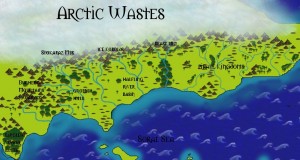The Curse of Iron
The Druids of Fridon call it The Curse of Iron. They have seen it many times over the ages. Once a person uses weapons of iron they can never put them down again. Inescapably, quick or slow, others will come for their iron. Or those around them will seek their own iron out of fear, tearing up the earth and felling the forests for fire to shape it. They will build stongholds and castles to keep it in their possession. They will enslave people to build for them and to work their fields. It will consume them and change them and all around them. And that is why The Druids and the wild elves and the hillmen of Fridon bury iron they find, praying for it to sleep again as they return it to the earth.
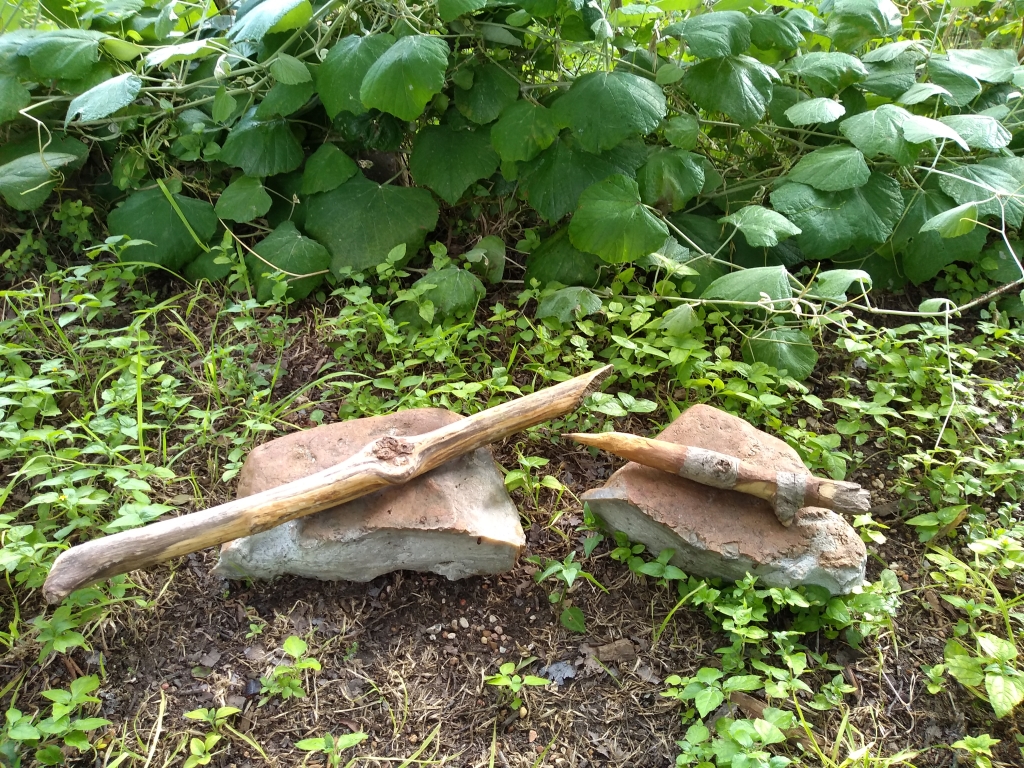
Fridon Elf short sword and dagger
Posted in Lore / Worldbuilding and tagged Soralia by Adam A. Thompson with no comments yet.
The Vampires of Grimsport
800th POST!
After 12 years and 799 articles detailing new magic items, monsters, spells, characters, encounters, locations, and adventures, Unicorn Rampant Publishing and Claw Claw Bite Magazine are thrilled to present you with this free adventure for Dungeons & Dragons or other fantasy role-playing games.
Thanks for coming with us on this amazing journey of the imagination, and look for this and so much more in the next issue of Claw Claw Bite!
Grimsport
In the land of Findor, where the Hadevar River meets the Soral Sea, the gray city of Grimsport broods. Dark stone buildings with slate roofs cluster around the main square, a short walk up the cobblestone road from the docks. There are found the homes of the ruling Captains’ families. Stone walls separate the inner city from the wooden homes of the tradespeople and serfs. Farms dot the banks of the river further inland.
It is from this city that the region gets it’s moniker “The Pirate Kingdoms.” Grimsport is the largest city in the region and the closest thing to a capital, and the primary source of the raiders that plague the Soral Sea. But in Findor no one rules an area larger than a stronghold or city, save the goblins of the northern wastes.
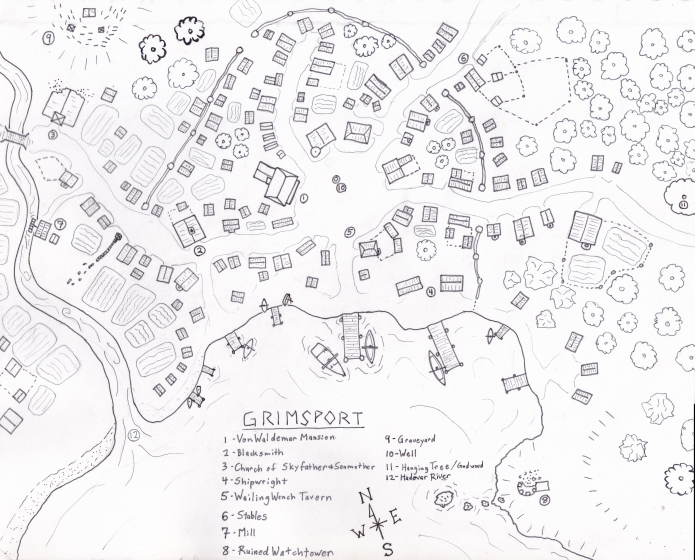
The Town of Grimsport
The boat-owning worthies who make their homes in the city center form the Captains’ Council, the closest thing to a government in this violent port town. They own most of the farmland and assign it to serfs. They serve as the bankers and trade in many goods. Some families have small fleets. Others have but one ship to their names.
The most important Capitans’ families are as follows:
- VonWaldemar – The wealthiest and oldest of the families, with the largest home on the central square. Said to be the descendants of some of the first humans to come to this wild, cold land many generations ago. Old man VonWlademar hasn’t been seen in public in years, and people sometimes whisper about pale, ghostly figures peering out of the heavily curtained mansion windows at night.
- Thyra Askrdottir – Daughter of Askr Vulfethson, Thyra’s exploits as captain of her father’s ship have earned her a reputation as a skilled and ruthless pirate.
- Addis Rígson – Addis owns two ships, which are captained by his two eldest sons Victor and Ricus. His youngest son Sigurd wanders the land seeking his fortune and could be a NPC or hierling met here or elsewhere.
- Soljev – Captain Soljev sails the Drunken Siren.
- Ragnhild – Captain of the Kraken’s Maw and the Burning Spear.
- Kromulf – The new captain of the Black Hydra, an infamous pirate ship that Kromulf wrested from its previous captain.
- Gunnar Smithson – Owns a small fleet of fishing vessels, sailed by his extended family, and the ship Silver Wave.
- Malte One-Hand – An old captain, now mostly retired due to his ship being in poor repair.
- Gull Erland – His ship is in drydock for repairs which he cannot afford.
- Eberhard the Bloody – Has one small ship and a reputation as a unpredictable and violent man.
- Bjarke Littlebear – Sails a large fishing boat with his five sons.
Locations
- The Wailing Wench – This rowdy tavern sits on the road between the main square and the docks, and is always full of sailors. Thieving, fighting, kidnapping and every other type of crime are regular occurrences here. A fenced pen and stables are attached to the back for travelers animals.
- Church of the Sky Father and Sea Mother – attended by a priest and priestess, with smaller shrines to other local dieties such as Krom, etc.
- Smithy – Worked by a smith and a team of apprentices and journeymen, with a good assortment of tools, weapons, and armor, used or ready-made.
- Shipwright – Currently building a 20 foot wooden currach.
- Tradespeople
- Farms
- Hanging Tree & Godswood
- Ruined Watchtower – built long ago by the Captain’s council, no repairs have ever been made to the watchtower. Over the decades it has fallen into ruin, and the whole north wall of the two-story tower has collapsed. None know about the small cache of treasure buried there.
Adventures and Encounters in Grimsport
- Thieves in the Swamps – A band of thieves operates out of the swamps to the west. They secretly use Malte One-Hand’s ship as storage for their stolen goods.
- Pressed into Service – Press gangs round up drunks and force them to crew the captains’ ships. While the Player Characters are crewing the ship any sort of mishap or adventure could befall them. The ship could sink in bad weather, throwing the heroes upon some unknown shore. Perhaps they are forced to scout a fortress the Captain wishes to raid, or perhaps the PCs are forced to be the first wave of the attack. The Lilend at the Stormking Rocks might lure them to her isle and send them after the Rune of Life in the shadowlands at the edge of the Land of the Dead.
- Pickpockets and Muggers – The rough rogues of Grimsport will take any opportunity to enrich themselves if they see people not paying attention to their purses, or who they think are weak enough to rob (preferably one character who they follow until they outnumber their victim).
- Dueling in the Streets – Disputes in Grimsport are often settled personally, and duels are a common form of conflict resolution, weather to first blood or to the death. In such a place the Player Characters could easily become embroiled in a dangerous situation. Mistaken identity, false accusations, or just disrespecting someone or being in the wrong place at the wrong time could result in a duel.
- Escaped Slaves – Some slaves captured in a raid have escaped and a reward is offered for their return.
- Beggars – Old crippled fisherman and seamen beg for alms in the square and by the docks.
- Grave Robbers – Graves dug on the hill behind the church are always found empty a week or so after burying. No one in town really seems to care, as this has been going on for as long as anyone can remember. Under cover of night, the ghouls who crew the VonWaldemar’s ships and attend them in their mansion are digging up the graves to feast upon the rotten bodies. Investigation after the next burial (a common occurrence) will lead the Player Characters to the basement door of the VonWaldemar mansion.
- Land Dispute – One of the Captains wants some land currently owned by another Captain and the Player Characters are asked to undertake some skulduggery. Burn the crops, poison the well, kill the farmers, or whatever is needed to get the current tenants off and new tenants on.
- Missing Servant Girls – Player characters who spend much time in town will hear that servant girls sometimes go missing. Investigation leads to the ghouls in the basement of the Von Waldemar mansion (see map).
VonWaldemar Mansion Areas
- The stone exterior, high windows, and peaked slate roofs of this mansion site like a dark and gothic castle on the town square. A fence surrounds the front and sides of the windowless bottom floor, and a stair in the back leads down to the basement entrance. The front door will not be answered unless it is being battered down, and then by ghoul butlers and Matrok, an armored wight who will demand to know what business interrupts the VonWaldemar’s rest.
- The ground floor has several mostly-empty halls, a decorative armory, and a small library of dusty common books. An undead shadow, the restless spirit of one of the long-dead Von Waldemars, haunts these halls and will warn Gunnar of any intruders.
- The basements are overseen by a ghoul named Harod and a flesh golem doorman named Pip. Peasant servants prepare food while ghoul footmen serve the vampires upstairs. The locked vault contains a large amount of plateware, iron ingots, and other loot pillaged from around the Soral Sea, along with several chests of gold, silver and copper coins, and two empty caskets where the vampires will flee if defeated.
- The sub-basement holds cells, a half-flooded chamber where corpses float in briny water, and their horrible feeding area. VonWaldemar, the vampire master of the house, is sometimes found here feeding with the ghouls among the cracked bones of countless people. A secret passage leads to a small, rough-hewn passage which leads to the town well, and is guarded by a gargoyle.
- The VonWaldemar family quarters are upstairs, as are the quarters of their wight guards and ghoul servants. Gunnar VonWaldemar and his daughter Helde are centuries-old vampires, and the only remaining members of the family. They are attended by several ghoul servants. Their quarters contain much finery, and any victims that they are feeding from. The windows in the vampires’ quarters have the shutters nailed closed and reinforced so that no sunlight can enter. Gunnar is a 7th level wizard, and his chambers contain his spellbook, many magic scrolls, and correspondence with someone who signs with a unique snowflake-like rune (the evil lich White Eye), and who has asked Gunnar to use an enclosed scroll of glacial onslaught to draw the oncoming unnatural summer ice south, down the river. If necessary, the VonWaldemar vampires will become bats or rats and use the ratholes, which crisscross the entire mansion with a network of rat-tunnels, to escape.
VonWaldemar Mansion
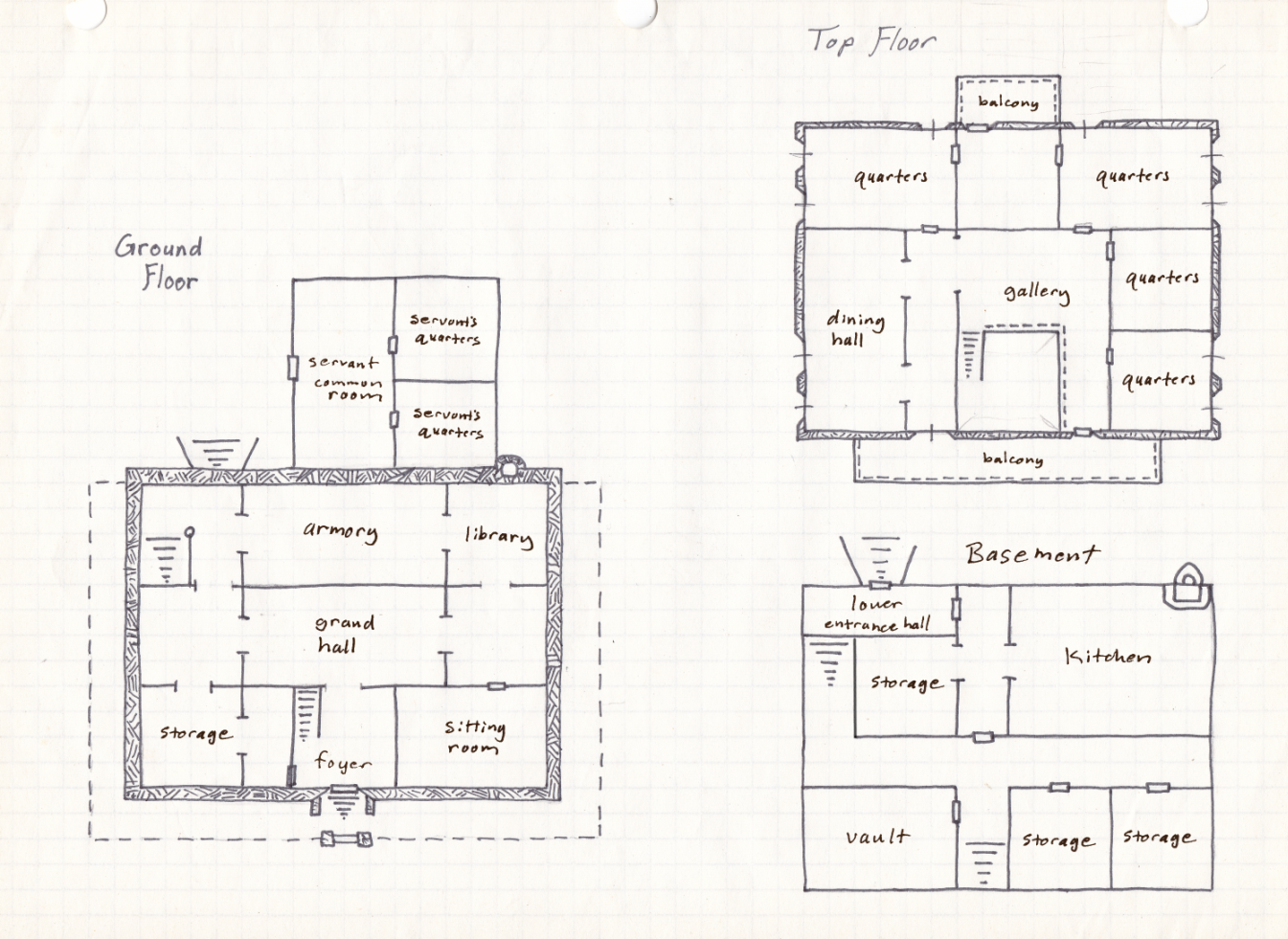
VonWaldemar Mansion Sub-Basement
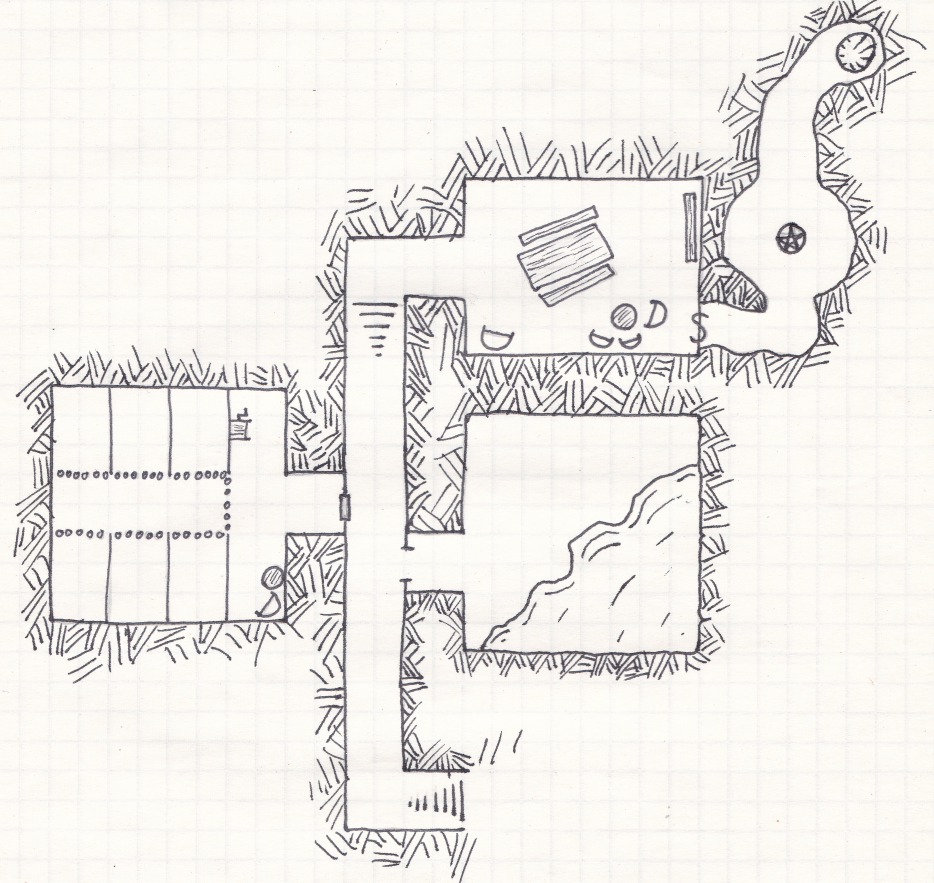
Background image by Nikolai Rerikh, Guests from Overseas, 1901, Tretyakov Gallery, Moscow (public domain)
Posted in 1st edition D&D, 3rd edition Dungeons & Dragons / d20 fantasy / Pathfinder, 4th edition Dungeons & Dragons, 5th edition Dungeons & Dragons, Adventure, Fantasy, Location, rules agnostic and tagged Soralia by Adam A. Thompson with no comments yet.
Sea Currents of Findor
At the farthest north-eastern reaches of Soralia, this region is marked on old maps as Findor. The land is more popularly known among the travelers of the day as The Pirate Kingdoms – named after the area’s sea-raiders, a plague of the Soral Sea. Strongholds, towns and villages dot the landscape alongside temples and ruins, marks of lineages and creeds both extant and extinct.
The ocean currents rule this land and shape its people’s ways. A general counter-clockwise current brings cold air southwest from the arctic above the pirate kingdoms down south within fifty miles of Setheria Isle, home of the archmages, which tower provides the marker for the shift in course from southwest to southeast. Continuing southward, the current skirts the Princedoms of Ogham, providing the first opportunities for those who rise this circuit for trade and plunder. From there it meets warm southern winds from the plains and deserts that form the southern bound of the eastern Soral Sea. The winds cool the southerly plains as raiders from the north trade and plunder as they will. The current then proceeds along with the prevailing wind and carries warm air west and then north across the Great Gulf, as the captains of the Pirate Kingdoms call it, seeing as there are no lands east of there. Careful, always keeping the shadows of their masts at their shortest on the left shoulder of the steersman as a guide for their return to Grimsport and the lands of their birth, lest they be carried into the northeastern sea and the isles of ice there. They return along with the warm spring rains from the south, which temper the chill pouring south over the peaks of the Barrier Mountains and water the springs, rivers, plains, woods, hills and valleys of this rough northern land.
Posted in Uncategorized and tagged Findor, Location, Soralia by Adam A. Thompson with no comments yet.
The Middle Kingdoms
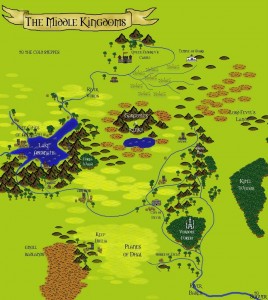 Geography
GeographyThe lands commonly referred to at the Middle Kingdoms are bordered on the east by the Kitel Woods, the north by vast steppes, the south by badlands and the tail of the Skullcrush Mountains, and stretch west to mountain-encircled Lake Abernath. The region consists of ranges of low mountains, interspersed with rivers and generally descending as the water flows east towards Soguer and the Soral Sea.
The Daren River and roads that follow it are a major route for trade and provide an avenue for goods traveling from all the far-flung shores of the Soral Sea to the tributaries that feed Lake Abernath and the free cities that surround it.
The northeastern portion of the area is marked by wild badlands surrounding a range of rocky, mountainous highlands, which trail off into goblin-infested hills. Further north are cold swamps.
The plains of Dahl in the southwest provide good grazing for the herds of the people there.
Lands and Peoples
A traveler who follows the River Daren north and west towards it’s headwaters will encounter the following lands:
Shires of Etela – If one follows the Aet River due west from the Daren they will come into the hills and valleys of the Shires of Erela. The halflings that live here are typical of their kind: somewhat reclusive but generally plain country folk. They are mistrustful of the horsemen of Dhal to their west, citing “unforgotten history.” Their lands begin at Aetford, where men, halflings and handfuls of elves live together by the large stone bridge.
High Elves of Verdone – Thick and quiet, the Verdone Forset seems foreboding to many who pass it on the River Daren. The tales of the uncaring elves that dwell within and their strange magics are whispered by boatmen. Few have seen their white towers, for the wood is said to be enspelled to confuse the minds of men and lose them among the tall, silent trees.
City of Devin – This city and it’s fortified castle grow large on the trade here at the meeting of the Rivers Bedeflow and Daren. A diverse city, it includes large populations of gnomes from the mountains to the east, elves from Verdone and halflings from the shires to the south.
Dhilic People – The men here are known to be superb horsemen and warriors, a tradition that is celebrated in passed down from father to son. They ride the plains of Dhal on their fine fast steeds herding their cattle, goats and sheep. In the villages in the hills surrounding Keep Dhilia they make leather goods and weave picturesque tapestries to warm their homes against the winter winds.
City of Argros – Vast fields of grain grow in the lands surrounding Argros. The peoples here tend to build their homes raised on posts to help them survive the spring floods of the Daren. Traditionally all landowners serve as pikemen in the militia, territorially guarding their borders from the men, gnolls, half-orcs, and wood elves surrounding them.
Marble Falls valley – Mining dominates this deep mountain valley and the small cities here. Mist from the many waterfalls clings to the leaves of trees in the ravines carved by the water’s slow hand. Fine stone gives the area it’s name. Animal sculpture is popular, and most homes have at least one large stone statue near the entrance to ward off evil spirits. The area is also noted for a large, beautiful shrine to WeJas, goddess of death and magic, carved into a cliff face in the northeast of the valey. Within the shrine is a huge marble statue of her opening the door to the next world for the departed.
Free Cities of Abernath – The shores of Lake Abernath are dotted by human cities, each a city-state unto itself. Farming, fishing and trading on the lake are the pillars of their economies. Mercantile and guild conflicts occasionally spill over into violence here, but actual war between the cities is generally seen as being bad for business.
Dwarves of Rolang – In the mountains on the eastern shore of Lake Abernath, the dwarves of Rolang delve into the bones of the mountains. Brass and iron are traded from here, and also grains that they turn into casks of their famous dwarven ales.
Elves of Forla Wood – This area is home to a large concentration of the semi-nomadic wood elves that move their homes all around the region. Every year representatives from each family meet in the sacred Emerald Grove to discuss issues important to the elves of the land. Bards from Forla’s tribes, while rare, are welcomed in all cities of the Middle Kingdoms for the news they bring and their exceptionally beautiful music.
Queen Zedhrev’s lands – From lake Abernath, further up the River Voros, at the foot of cold mountains, Queen Zedhrev sits in rulership. Her lands stretch through the swamps east to the Temple of Stars, and west along the R. Voros. It is generally agreed that she is a powerful sorceress, and she is mentioned in many stories and legends in the Free Cities, usually as a cruel and bloody villain.
Temple of Stars – The largest temple to Baccob in the known world, this site is said to be of importance due to it’s position beneath certain constellations. Some say the view of the stars from the high hills in the clear cold air is why Baccob blesses this temple. It is only one of the many secrets of this temple. The priests here are on good terms with Queen Zedhrev to the west, and she gives them their solitude and protection from the barbarians and bestial peoples to the east. It is said that they gave her her sorcerous powers. It is also said that they resent and fear her power, and the truth of it is known only to them and her.
In later ages, this temple becomes the site of the final siege of the Anmagus Crusade of the Sword of Light. See also the Cult of Shan’n’nur.
Bare Peaks – The barren mountains of these highlands are home to groups of gargoyles and kenku, and no travelers go here. The gargoyles of this region call themselves the Dz’ata Möschu.
Lord Fevul’s Lands – These dry badlands and rough, scrub covered hills are home to various goblinoid tribes, and have traditionally been an evil place to be avoided. Recently, however, the elves living to the east and south have been reporting raiders emerging from this area. They claim that a warlord named Lord Fevul has united the goblin tribes and that Magublet, the goblin god, sits at his side. In times past, the barbarians to the northeast with whom they skirmished, the Kitel Elves, and the swamps and mountins to the west have provided defense against these peoples, but now there are whispers of worry that a great host may soon march out of those brown hills.
Akmak and the half-orc lands – In the lands surrounding the Bare Peaks are scattered villages and small cities of predominantly half-orc people. Their traditions claim that they are descended from an ancient race of warriors, and they are indeed fierce fighters who’s walled city of Akmak is a testament to their grim, martial culture.
Dwarves of Sturm Mountain – The dwarf clan that calls this mountain home have built an extensive stronghold deep into the bones of the land. The clan ruler, Oxymazus Axehand rules his people with strict laws adhering to Moradin’s dictates. As a people they are extremely unwelcoming to any but their own, and the entrances to their mountian fastness are guarded day and night by dwarves in bright suits of mail.
Tehton – The hills, valleys and forests of Tehton are home to hardworking woodsmen and skilled carpenters with a strong code of ethics. The peoples here also have a close affinity with the various fey in the mountains from sprites to wood elves. Their largest city is called Forston, at a fork where the River Aelle meets the River Bedeflow.
Rumors and Information
The following can be determined with the corresponding Knowledge (local) or Bardic Knowledge check: (leave comments to create the rumors and information)
Posted in Region and tagged Middle Kingdoms region, Soralia by Adam A. Thompson with no comments yet.
Lands and peoples of northeast Soralia
Soralia is a continent you can use as part of your campaign world. I created this land while running several campaigns in it over the last seven or so years, and now that I feel like it’s fairly well flushed out, I’d like to share it with everyone on Claw Claw Bite.
Climate: the northern kingdoms are warmer than their latitude is generally, due to a major warm current that flows counter-clockwise north into the Soral Sea, past the northeastern shores of the Princdoms of Ogham, and then west along the northern shore of the Soral Sea. This warm current results in heavy mists and fogs along the coasts of the so-called Pirate Kingdoms that stretch from the eastern edge of the peninsula to the halfling lands in the wide river basin that dominates the central portion of this region.
The Dwarvish lands are high and cold, set in the sprawling Dunheng Mountain chain that shields the eastern lands from the cold north western winds. The gnomish lands are a temperate and fertile land of hills and rivers which flow down from the dwarvish lands. The lands east of there with their small human kingdoms are warmer still in the southern reaches where the warm current runs strong. In the norther reaches they become more temperate as the lands rises slightly towards the arctic barrier mountains. These lands are drier and less fertile than the gnomish lands to the east.
Lands and Peoples: As one travels from west to east from the Fridon kingdoms along the north shore of the Soral Sea, one encounters first elvish, then dwarvish, then gnomeish, then halfling lands, followed by a stretch of heavily wooded wilderness, and several small human kingdoms.
Elvish Lands: Many clans of wood elves make their homes in the Linglew Woods. The elves are generally inhospitable to outsiders, and the humans of Fridon and the dwarves of Dunheng avoid their trackless forests.
Dwarven Kingdoms: two large and several small sovereign dwarven kingdoms claim the Dunheng Mountains and the surrounding land as theirs. Fairly isolate and xenophobic, these dwarven kingdoms have long-running feuds that occasionally break out into brief wars. Smaller kingdoms will be on one side or another as events change over the years.
These dwarves have some commerce with the underdark, primarily with deep dwarves and undergnomes. Other commerce is with occasional elvish or Fridon traders from the west and gnomes to the east, and through them, the warm human Pirate Kingdoms. Many young dwarves from these lands hire themselves out as small companies of mercenaries to the gnomes, halflings, and humans to the east.
Gnomish Lands: These lands are primarily gnomeish citiy-states ruled by family clan councils. The population includes a smattering of halflings, dwarves, humans and the occasional elf. Their economies are primarily agrarian. For defense, the ruling councils use mercenary troops sparingly and wisely to defend against human raiders from the east. As their lands are not rich in precious metals, they tend to be at peace with the dwarven kingdoms of the Dunheng Mountains to their west. They conduct extensive trade with the dwarves to the west and the halflings to the east, and the region has good roads.
The gnomes that live here tend to be practical, stoic folk, well used to defending themselves from the human bandits that spill out of the Pirate Kingdoms to the east. To their north in the tail of the arctic barrier mountains tribes of Ice Kobolds and the Naahaogo mountain goat people occupy the last habitable stretch of land before the tundras and arctic wastes. Mixed among them in the rolling foothills west of the river basin are several small halfling, elven and human communities of hill people.
Pirate Kingdoms: The lands of Findor, more popularly known as the Pirate Kingdoms, are small and factious kingdoms that stretch out across the end of the northern Soralic peninsula. On the whole, they tend to be somewhat poor and rather chaotic. Due to the lack of law in this region, they are a haven for pirates for which they are known, mainly out of the city of Grimsport.
One kingdom is ruled by Erikur Rinaldus, the famous “Mad King” of Pitosala, a small state in the Pirate Kingdoms. Cursed with a split personality, his fits and shrewdness are famous. His main personality is an aristocratic, regal and charismatic, and his next dominant personality is a mighty wizard, shrewd, cruel and scheming, with a third personality which seems to be a babbling mix of voices.
The humans here tend to view dwarves with a bit of distrust, as their main contact with them is as mercenaries. Ruins of the long-dead Sea Dwarves dot the land.
Ice Kobolds: These Kobolds have a blue-white color to their scales and a natural resistance to the cold (cold subtype: cold immunity). They worship the white dragons that live on the arctic shelf and throughout the barrier mountains. There is enmity between them and the beast-men that share these mountains, but they do not tend to make war on each other. They come into frequent conflict with the hated gnomes and to a lesser extent with the dwarves that live in the Dunheng Mountains to the southwest of them.
Their king is a mighty sorcerer-warrior who has magically transformed himself into a half-dragon. Also of note among them is a powerful sorcerer who builds fantastic constructs for use as war machines against the gnomes in the caverns, some in the aspect of the dragons they worship. He often must work with other magic-users to complete these constructs, but has the support of the king and good access to the resources he needs.
Beast Men (Na’ah-aogo): Known as beast-men by their human neighbors, but calling themselves the Naahaogo, these creatures dwell in the barrier mountains north at the headwaters of the river that flows through the wild woods separating the gnomes and humans. They are thought of as dangerous savages by the humans south of them, and have fought settlers and raiders from the human kingdoms. They are organized into small family units and are primarily nomadic gatherers.
They have the aspect of men with the head and hind legs of a goat, with a thick pelt of fur across their entire bodies, giving them good resistance to cold weather. They receive a +4 racial bonus to jump, climb and balance checks and are well suited to the mountain terrain in which they live. They receive a +1 racial adjustment to dex and con and a -2 adjustment to intelligence and -1 to charisma. Their favored class is ranger, but scouts, druids and barbarians are common among them. Their society tends to be neutral and slightly chaotic as do individuals. They fight with longbows and spears, though their warriors favor many weapons such as greataxes, greatswords and longspears.
Rumors and Information
The following can be determined with the corresponding Knowledge (local) or Bardic Knowledge check…. (use the comments section to add rumors for this region)
Posted in Region and tagged Soralia by Adam A. Thompson with no comments yet.
Naahaogo: the mountain goat people
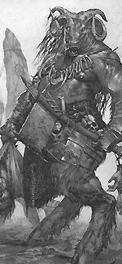
Beast Men (Na’ah-aogo): Known as beast-men by their human neighbors, but calling themselves the Naahaogo, these creatures dwell in the barrier mountains north at the headwaters of the river that flows through the wild woods separating the gnomes and humans in the lands on the north shore of the Soral Sea. They are thought of as dangerous savages by the humans south of them, and have fought settlers and raiders from the human kingdoms.
They are organized into small family units and are primarily nomadic gatherers. They have the aspect of men with the head and hind legs of a goat, with a good pelt of fur across their entire bodies, giving them a hardy resistance to cold weather.
They receive a +4 racial bonus to jump, climb and balance checks and are well suited to the mountain terrain in which they live.
They recieve a +1 racial adjustment to dex and con and a -2 adjustment to intelegence and -1 to charisma.
Their favored class is ranger, but druids and barbarians are common among them.
Their society tends to be neutral and slightly chaotic as do individual members of the race. They fight with longbows and spears, though their warriors favor many weapons such as greataxes, greatswords and longspears.
Posted in Uncategorized and tagged race or culture, Soralia by Adam A. Thompson with no comments yet.
